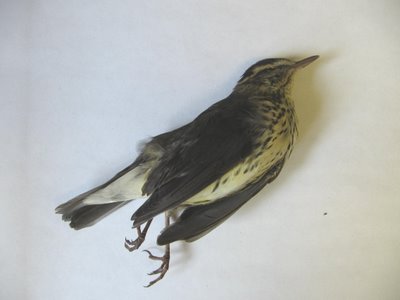
This is not the way I prefer to have my first sighting of a bird species. I found this one recently killed, probably by an automobile, on a street in town as I was going for a noontime walk.
If I had been moving at a faster pace, even bicycle speed, I would have missed it entirely, or dismissed it as one of those "little brownish birds" that cannot be identified from a moving vehicle. But because I was walking, I gave it a look longer than a millisecond and knew that this was not something in my realm of ordinary. Although I have been identifying birds for over thirty years, I did not recall seeing this one before.
It was just under six inches in length, with dark olive-gray back and wings and a lovely pale yellow breast spotted with gray-black. The spots were arranged slightly in streaks, and the bird had a buff eye stripe. The narrow bill suggested a warbler or vireo.
If I had brought my digital camera with me, as I usually do, I would have taken a picture or two and placed the bird off the street, in a more dignified place. I was a block away from the office, barely starting out, so I didn't feel like turning around already to bring the bird back to the office for identification. So I walked about a mile holding a dead bird lightly in my hand. Other birders would understand, wouldn't they?
I brought it in and showed my coworkers; I did not have a bird guide with me but my boss had one, from his ornithology class he said. It was at least 25 years old, but I noted the pages were in near perfect condition, barely used. He is obviously not a serious birder. I had grown up with that particular field guide, so I knew just where to find warblers, and there it was, on the same page as the ovenbird: Northern waterthrush.
This one was probably a migrant; they are, I guess, fairly common north of here and I would not be surprised if I had a few of them over the summer at Sand Creek. They prefer wooded riparian areas and bogs, not city streets. They winter in Central and South America. It always amazes me how a bird I can hold in the palm of my hand can navigate such amazing distances. I wish this one had been more successful in its journey.
6 comments:
Too bad for the bird, but if a birder had not passed by, it would have been even sadder ...an anonymous end instead of one noted and regretted.
I hate to think of all a bird's been through only to die at the side of the road like that.
I think it's saddest to find them in the Spring, after having journeyed so far.
At least maybe yours was able to breed this year.
Pretty bird and not so easy to see usually.
The bird has been blessed by your sensitive spirit and great appreciation, Deb. Thank you for passing that along to us.
PS The staghorn berries were perfect this past weekend. They still had some lighter shades of mauve mixed in with the darker red--usually I wait until all of them are dark red--but this year's 'ade was the best I've ever had. It was full of "berry" and deep perfume. Hope you'll be able to brew some soon too.
lene- with dead waterthrush in hand, I did walk around the fish rearing ponds at work and noted the ripe staghorn berries. I plan to return, maybe tomorrow if I'm not busy and don't find any more dead birds!
We get these here a lot but I find it difficult to tell them from the Louisiana waterthrush, unless they're pretty yellowish underneath (in which case it's definitely a northern).
I hope you get to see a live one. It's so cool the way they constantly bob their tails all the time. A lot like the spotted sandpiper, if you're familiar with that one.
Post a Comment